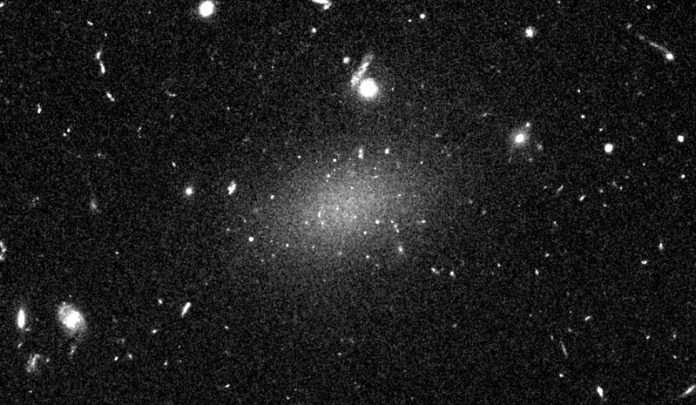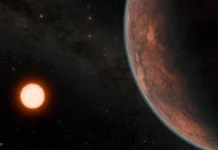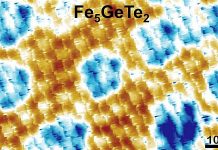
Astronomers have discovered a galaxy with very little or no stellar mass.
Galaxies like these are called ‘dark galaxies.’
It contains clouds of gas but very few stars, possibly none. This is the only isolated dark dwarf galaxy in the local universe.
All galaxies are made of mostly dark matter. Visible matter, like stars, gas and dust, makes up only a small percentage of a galaxy’s mass.
But galaxies like this one, named FAST J0139+4328, are even more extreme, and its low luminosity suggests there are no stars, only clouds of gas.
The astronomers who discovered it say the galaxy is “without any optical counterpart.”
Astronomers found the new dark galaxy with the Five-hundred-meter Aperture Spherical radio Telescope (FAST) and the Panoramic Survey Telescope and Rapid Response System (Pan-STAARS.) It’s a newly discovered galaxy and appears in most ways to be a typical disk galaxy. But it has an extremely low magnitude and low stellar mass.
“These findings provide observational evidence that FAST J0139+4328 is an isolated dark dwarf galaxy with a redshift of z = 0.0083. This is the first time that an isolated dark galaxy has been detected in the nearby universe,” the researchers write in their article.
The research article is “Discovery of an isolated dark dwarf galaxy in the nearby universe.” The lead author is Jin-Long Xu from the Chinese Academy of Sciences and the National Astronomical Observatory. His co-authors are also from Chinese scientific institutions.
A redshift of z = 0.0083 means the galaxy is between about 1 million and 1.25 million light-years away.
It’s an isolated HI cloud, meaning it’s a cloud of neutral hydrogen rather than ionized hydrogen or molecular hydrogen. The researchers say it’s in the form of a disk galaxy due to its shape and its rotational structure.
Modern cosmological theory explains the relationship between dark matter and galaxies. Theory says that dark matter haloes contain galaxies as if the dark matter provides the structure for the galaxy to form.
The halo envelops the entire galactic disk and extends beyond the edge of the visible galaxy. Astronomers can’t see dark matter, but they infer its existence because of its effects on objects around it. The haloes play a critical role in galaxy formation and evolution according to our current models.
Dark galaxies like this one are oddballs. Astronomers think that their gas failed to form stars. That’s why astronomers think they’re critical in understanding how galaxies form and evolve.
“Furthermore, the discovery of dark galaxies is crucial to understanding galaxy formation since gas-rich dark galaxies may reflect the earliest stage of galaxy formation,” the authors explain.
This dark dwarf galaxy and others like it could also help solve a problem in cosmology. The Cold Dark Matter (CDM) model predicts that there should be more dwarf galaxies than astronomers have been able to observe. It’s called the missing satellite problem or the dwarf galaxy problem.
The Milky Way has 11 dwarf galaxies, and the Local Group has about 38, according to observations.
But the dark matter simulations show there should be about 500 dwarf galaxies as satellites of the Milky Way alone. Dark dwarf galaxies like this one could plug that gap and strengthen our understanding of dark matter and the cosmos itself.
While dark dwarf galaxies like this one are definite oddballs, they’re not the only ones. Astronomers have also found galaxies that contain little or no dark matter, though that finding is still controversial.
In 2018 a team of researchers published a paper titled “A galaxy lacking dark matter” in Nature. NGC 1052 is a group of galaxies, and the authors of the 2018 paper identified an ultra-diffuse galaxy named NGC 1052 DF2.
“NGC1052–DF2 demonstrates that dark matter is not always coupled with baryonic matter on galactic scales,” the authors of that paper wrote.
A subsequent paper published in 2019 announced the detection of another ultra-diffuse galaxy with no dark matter in the same region named NGC 1052 DF4.
In their article’s conclusion, the authors explain the significance of finding a dark dwarf galaxy.
“This is the first time that a gas-rich isolated dark galaxy has been detected in the nearby universe,” they write. “In addition, a galaxy is assumed to form from gas, which cools and turns into stars at the center of
a halo. FAST J0139+4328 has a rotating disk of gas and is dominated by dark matter but is starless, implying that this dark galaxy may be in the earliest stage of the galaxy formation.”
These dark dwarf galaxies may just not have enough dark matter to hold onto their gas. It may be that the amount of gas is too small to trigger Toomre instability in the galaxy’s rotating disk. Without stars, these dark dwarf galaxies are extremely faint and difficult to detect.
They can only be detected by looking for neutral hydrogen (HI) rather than by electromagnetic radiation. To find more of them, we need more HI surveys.
“Future blind H I surveys with high sensitivity and high-velocity resolution are expected to contribute considerably to our understanding of the absence of ultra-faint galaxies,” the authors conclude.
Written by Evan Gough.
Source: Universe Today.



